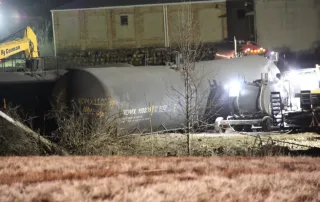Features
Midwestern Apiaries are a Sweet Thing
The USDA attributes the pollination of 15 billion worth of crops in the U.S. annually to honeybees. This insect alone contributes between 1.2 and 5.4 billion dollars in agricultural productivity by pollinating 80 percent of all flowering plants, including more than 130 fruits, nuts, and vegetables.
The Secrets of a “Homeless Influencer”
Huck Finn had his river, Kerouac his road, Ishmael his sea. Sham has his abandoned buildings. All 21 of them. Eighteen abandoned, two under construction, one still operational. Ten cities. Thirty-five hours of exploration.
Color Bursts – The Utopian Art of Avery Williamson
Williamson struggled with processing the emotional weight of living in what seemed like relentlessly unprecedented times. "At the time, I was thinking about them as... a place to capture competing, strong emotions."
New York, Los Angeles, Columbus?
How art can grow from Midwestern roots.
Labor, Solidarity, and Nursing
Soon, nurses saw the gulf widen between their values and those of an increasingly commodified healthcare system.
Unbreakable: Glass in the Rust Belt
What’s left of domestic glass manufacturing in the U.S. remains concentrated in the Rust Belt–eight of the industry’s top ten employers are in Pennsylvania, New York, and the Midwest. But studio glassblowing is adding relevance to a material long forgotten by many communities shaped by it. Today, the Rust Belt is home to three of the United States’ top five hubs for glass studios.
“Poetry for Everybody” – Doralee Brooks in Allegheny County
Life-long educator and poet Doralee Brooks named new Poet Laureate for Allegheny County.
Dreaming at the Mattress Factory
Given that the Mattress Factory once made literal mattresses, the place where dreams most often form in our minds, it feels fitting that it’s now a site for collective dreaming.
The New Stewards of Skateboarding
People like Sie and Scar and Dani and Frances are the future of skateboarding; they are part of a major sea change that will not only shift the demographics of skateboarding, it will also fundamentally alter its ethos. These are the new stewards of skateboarding.
Hindsight and Regulation in East Palestine, Ohio
In the aftermath of the derailment, which released toxic chemicals into the streams and air around East Palestine, many are wondering how the country’s regulations around rail traffic could have allowed a train with 20 cars of hazardous material not to be considered a “high hazard.”

Get the latest stories from around the region sent straight to your inbox.

Get the latest stories from around the region sent straight to your inbox.
Support independent, context-driven regional writing.
















